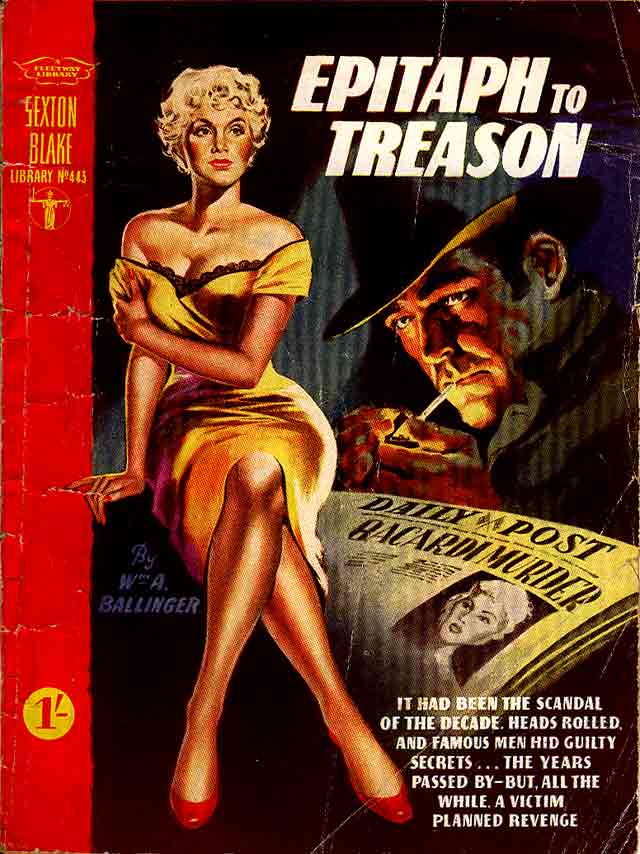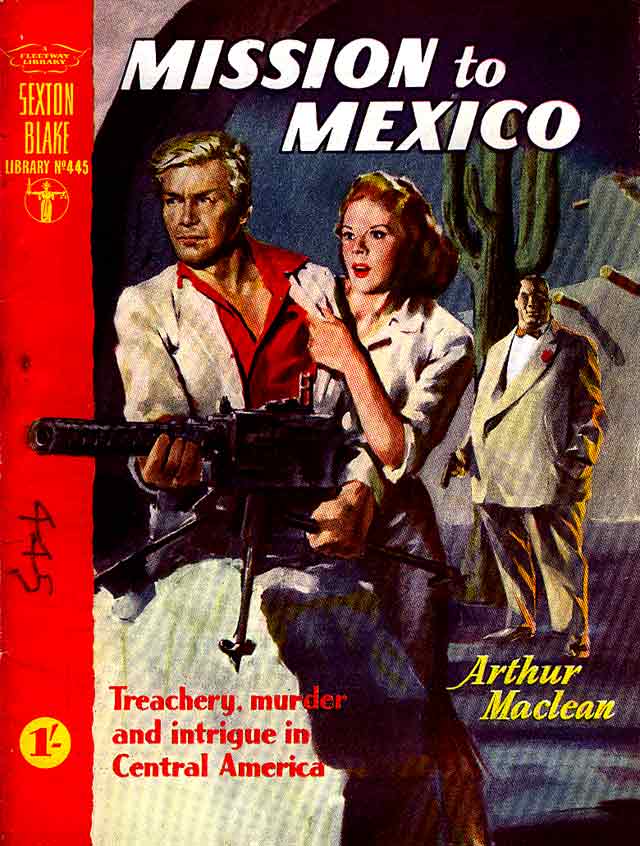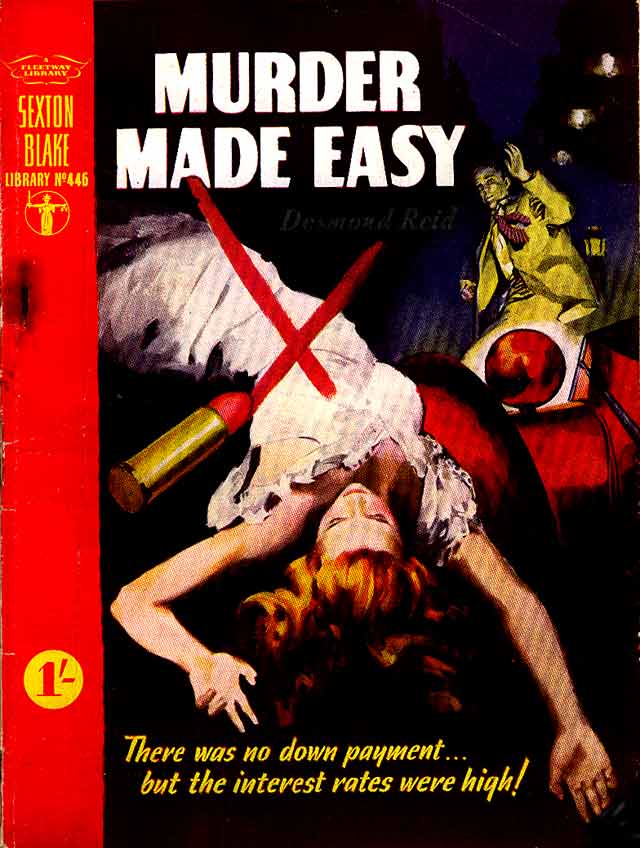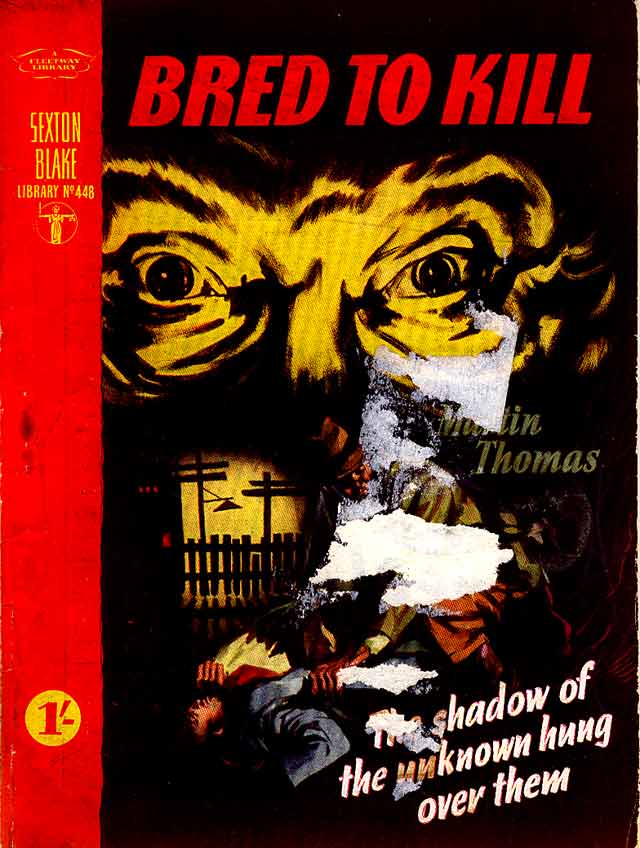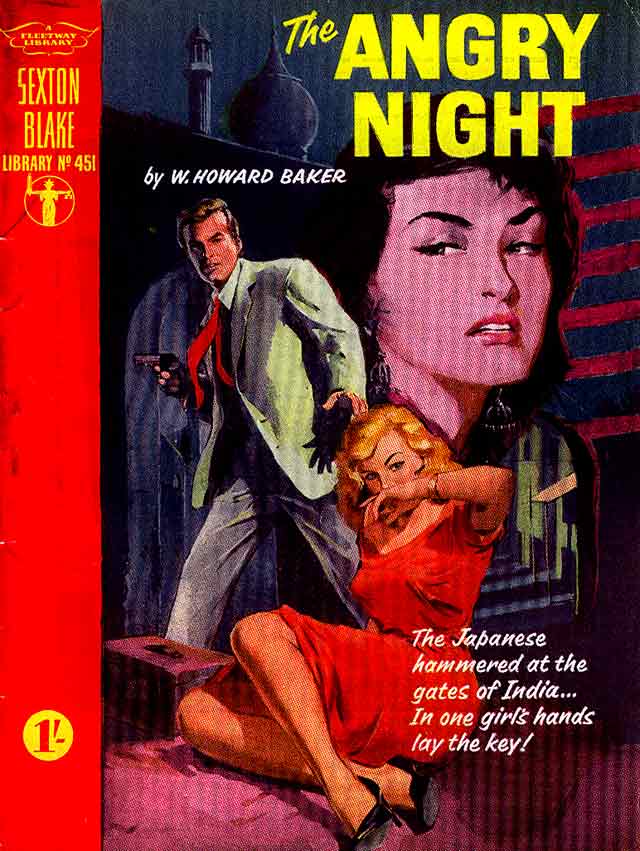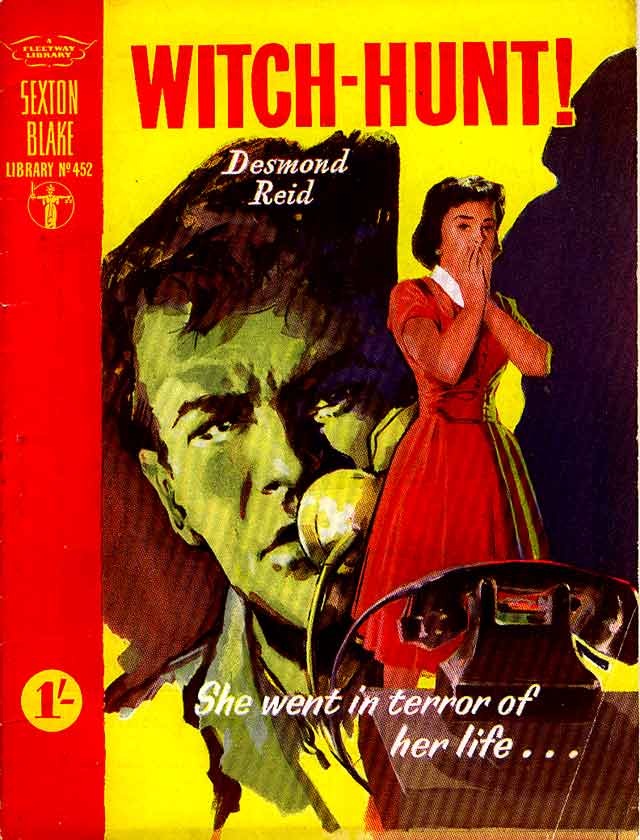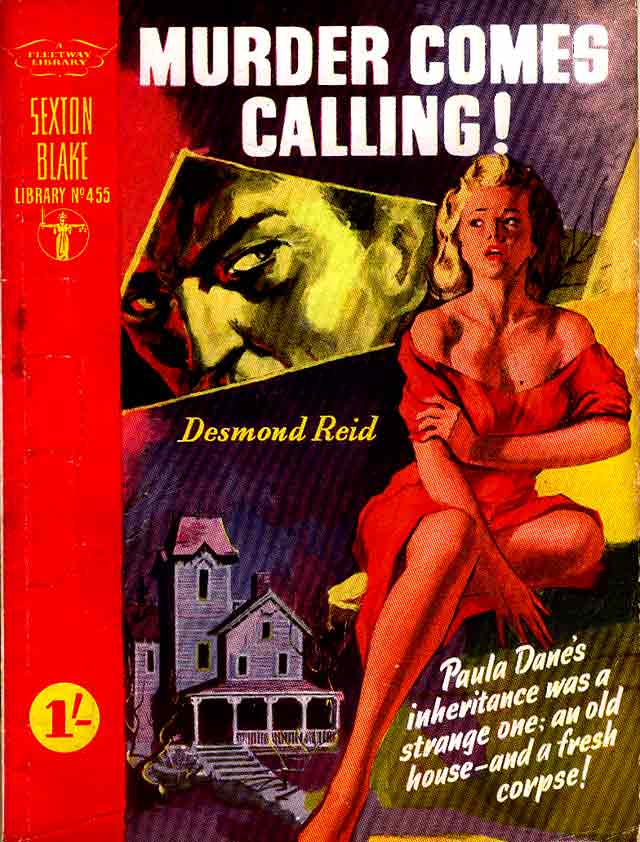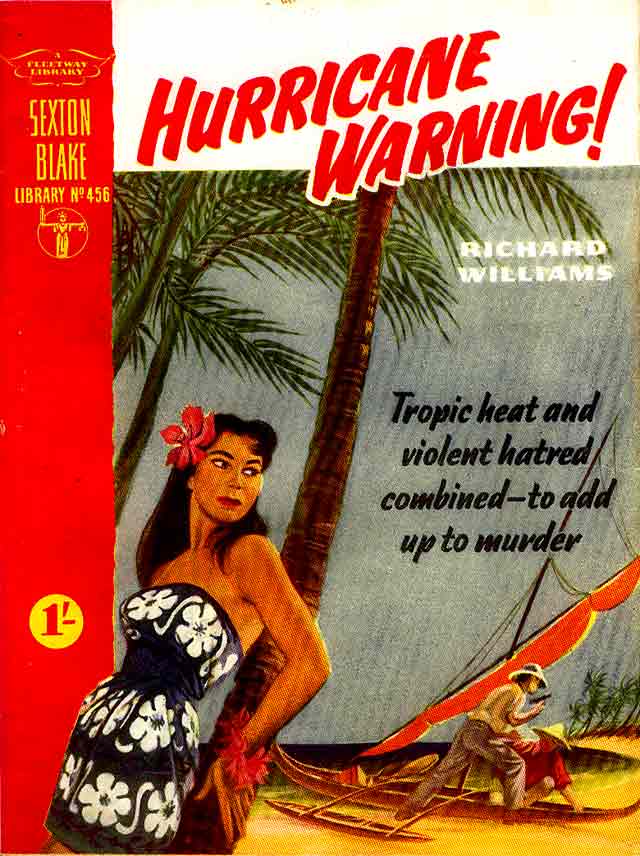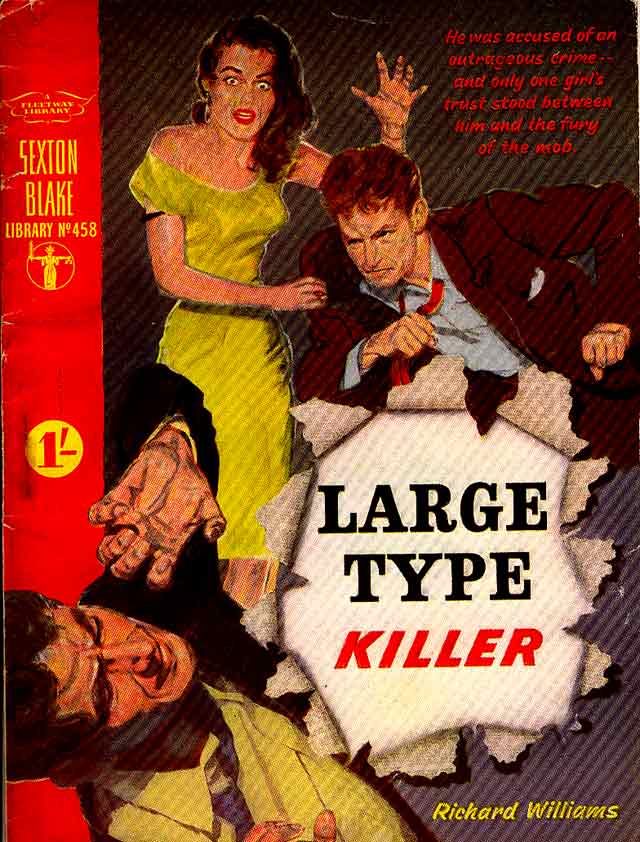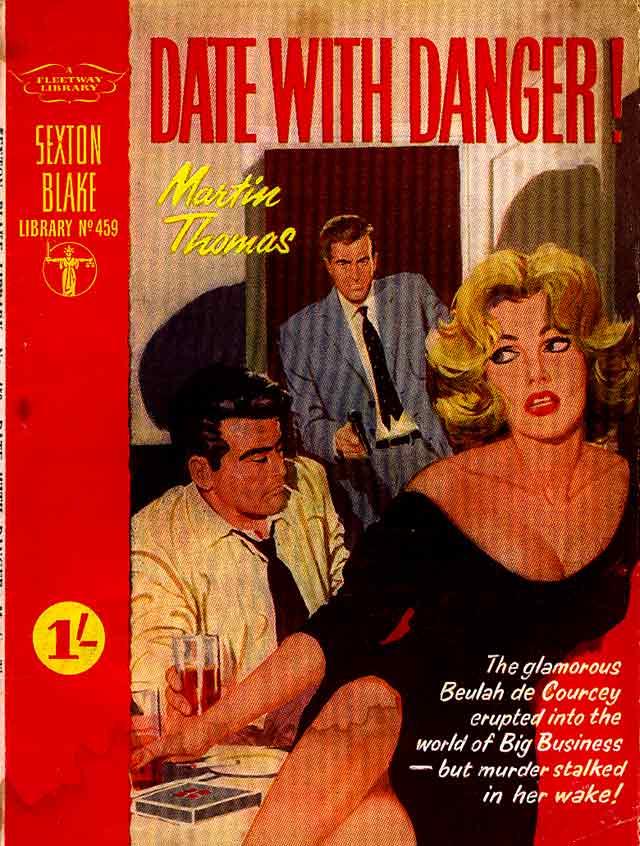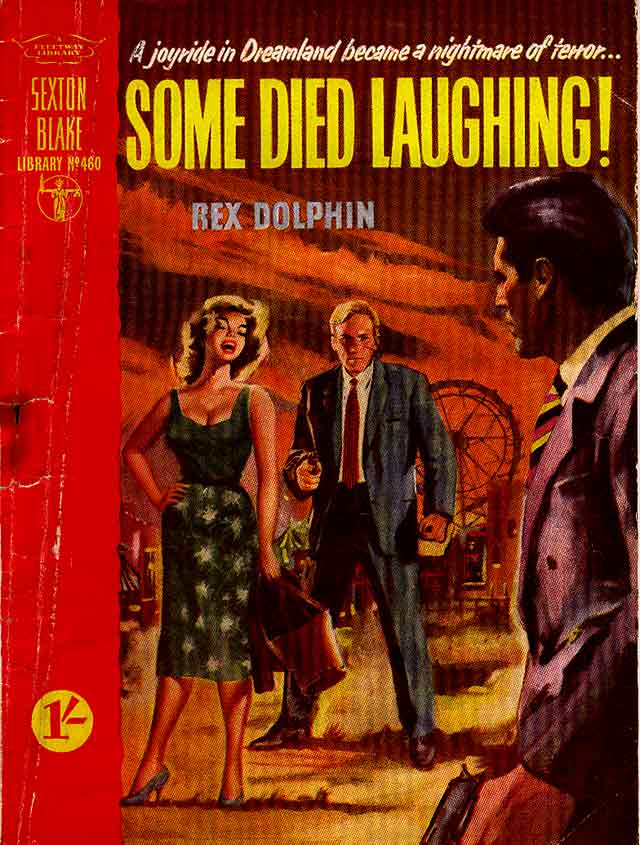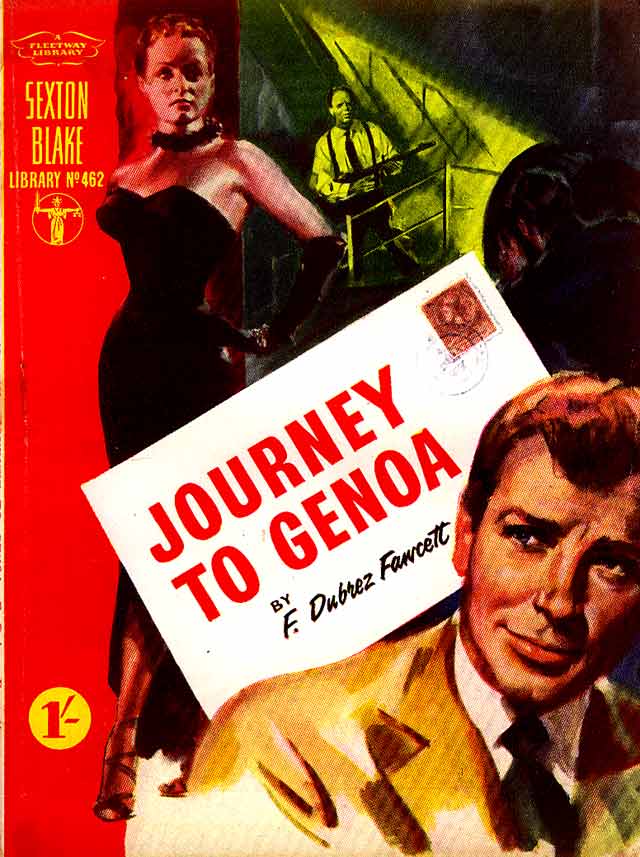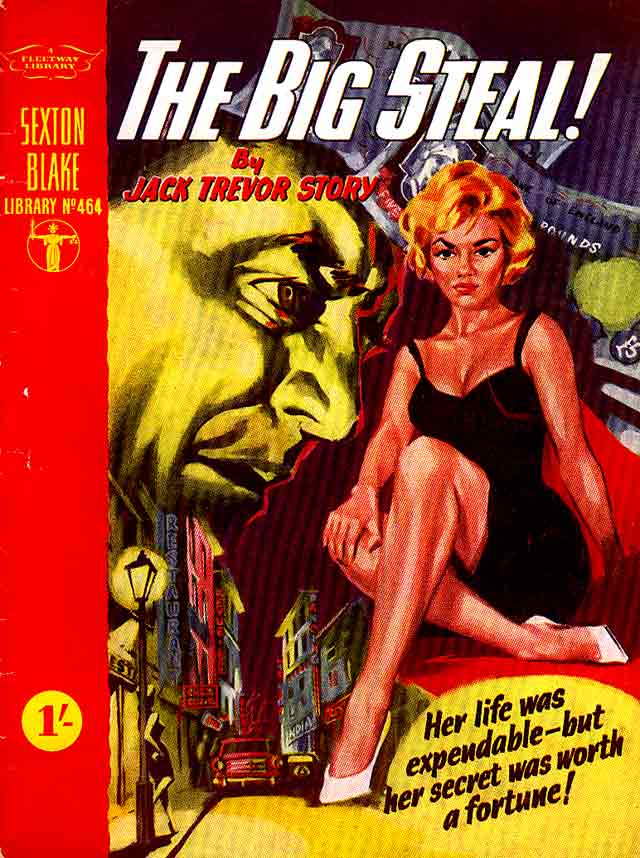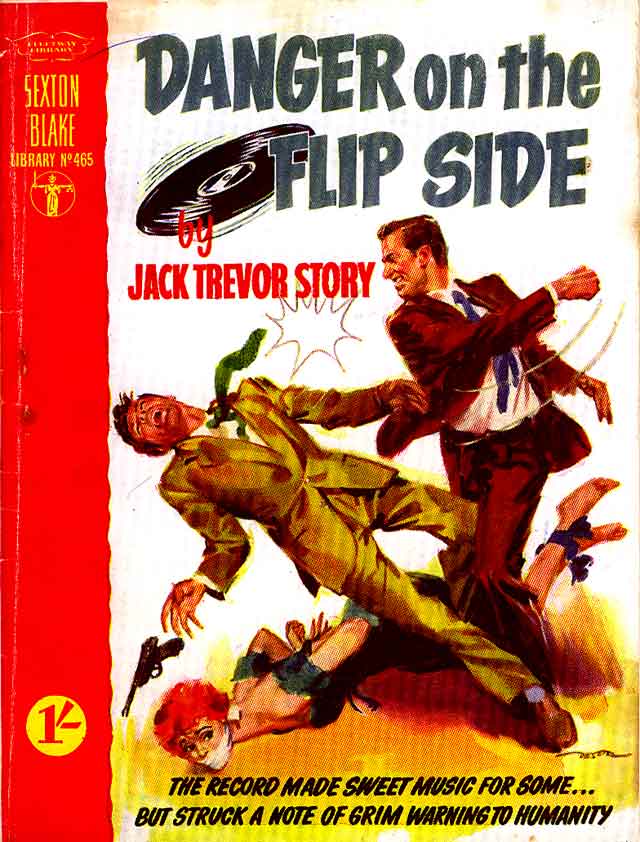Sexton Blake Bibliography: 1960
Publishing: After twenty-one years, Sexton Blake's near unbroken run in KNOCKOUT comes to an end. The tales during first decade, such as those featuring Hoo Sung and the Rolling Sphere, were great fun, with dynamic artwork and exciting plots. The second decade, unfortunately, saw a steady deterioration, with the final "Sexton Blake of Scotland Yard" sequence being virtually unreadable.
Notes: None at present.
Trivia: This is Sexton Blake's final appearance in KNOCKOUT.
Unrated
Illustrator: Anon. (W. Bryce Hamilton)
Notes: Sexton Blake, Tinker and Pedro travel to the west country to meet with Anna Tremayne. She explains that her uncle Reuben, who was a hermit, had died and left her a fortune. However, she has found no trace of his rumoured treasure. Anna has also seen mysterious figures lurking around the cave where her relative had lived. As the detectives investigate near the cave, a helicopter lands on the beach and gun-toting thugs disembark. Blake takes pebbles, which he finds in the hermit's kettle, and throws them at the crooks, missing by a wide mark. The villains search Blake, Tinker and Anna before stripping the cave of all Reuben's possessions and making away with them in the helicopter. Blake sends Pedro to sniff out the pebbles he'd thrown. He then scrapes them with his knife to reveal a pearl concealed in each. The hermit had concealed them in the kettle and allowed them to become coated with deposits from the hard water.
Trivia: This strip is reprinted from KNOCKOUT 811 (1954).
Rating: ★☆☆☆☆
Illustrator: Anon. (W. Bryce Hamilton)
Notes: Sexton Blake and Tinker are in the office of Sir John Chesworth when they encounter Professor Pawson, who's in charge of rocket research. The professor has been accused of miscalculations, leading to the loss of a number of projectiles. Furthermore, as Sir John explains, secret atomic information is being leaked to a foreign power. Pawson takes the detective to the rocket range on the Scottish coast, where test rockets are fired out to sea. While Blake examines a launch pad, the professor's assistants plan to fire the rocket, killing him in an apparent 'accident'. Tinker overhears this and warns his guv'nor. Documents are found on the two men and Blake realises that they have been concealing secrets in the rockets which are being picked up at sea by foreign agents. The detective sets a trap for the villains and they are captured ... clearing Professor Pawson of suspicion.
Trivia: This strip is reprinted from KNOCKOUT 793 (1954).
Rating: ★☆☆☆☆
Illustrator: Anon. (W. Bryce Hamilton)
Notes: Rocco Flint is the main suspect after a £50,000 jewel robbery but his whereabouts are unknown. Sexton Blake wants to talk with one of Flint's former henchmen — a man known as 'Fingers' Olson — but as he approaches, Olson is shot and wounded by an unseen assailant. Blake is able to identify the gunman as a man named Carusoni, who is aboard a passing train to Manchester. The detective, with Tinker, flies north to meet the train and captures Carusoni, who proves to be a disguised Rocco Flint.
Trivia: This strip is reprinted from KNOCKOUT 779 (1954).
Rating: ★☆☆☆☆
Illustrator: Anon. (W. Bryce Hamilton)
Notes: Professor Brand, a famous geologist, sends for Sexton Blake after his earthquake detector picks up three seismic events which no-one seems to have noticed. Blake deduces that the professor's house has been mysteriously shaken three times. The detective hires a local fisherman's boat and rows it into a cave beneath the house. Here he finds evidence of three impacts on the clay wall. That night, having worked out that conditions indicate that another 'earthquake' might be due, Blake rows back to the cave in another boat. He finds that the fisherman has left floating lights around the entrance. The detective drags them to a new position near the fisherman's hut. Some time later, a vessel fires a torpedo which destroys the hut. Blake finds, inside the dummy torpedo, a shipment of smuggled goods. Such shipments had, on previous nights, been fired into the cave to be picked up by the fisherman.
Trivia: This strip is reprinted from KNOCKOUT 785 (1954).
Rating: ★☆☆☆☆
Notes: Super-star guitarist Larry Bacardi receives a basket in which he finds the corpse of his young and beautiful step-mother. She has been poisoned. Accompanied by Splash Kirby, Sexton Blake interviews Bacardi's father, an ex-prizefighter, and discovers that no love was lost between him and his now dead wife; they had split acrimoniously after only a few short months of marriage. Kirby is called to see Lord Charmwood, the owner of the newspaper empire for which Kirby works. Blake, meanwhile, tracks down Bacardi, who has gone into hiding in a suburban cottage, and is offered £20,000 to stop investigating the murder. He refuses and is thrown out of the house. Kirby informs the detective that Charmwood has commissioned him to continue the case ... and when Blake meets his new employer, he immediately deduces that Charmwood is being blackmailed. So now he, Kirby, and the latter's new secretary, Lucille, have two crimes to investigate. The trail leads back to 1938, when Charmwood had hosted a political meeting from which state secrets had been stolen. Blake realises Barcardi has some sort of connection with that event and that he, rather than his step-mother, was the murderer's target; she was killed by accident. When another murder attempt fails, Bacardi decides to flee and books a flight out of the country. Blake tries to intercept him at the airport but the killer beats him to it and the detective only just manages to save the star's life. Blake gathers all the suspects together, untangles the mystery, reveals Bacardi's true identity and identifies the killer.
Trivia: Mrs. Bardell has a niece named Gloria.
Rating: ★★☆☆☆ This is fun but the identity of the killer, when revealed, is a little too unexpected and stretches credibility to breaking point.

Notes: This case dates from 1942. When it becomes apparent that a spy is operating at a very high level at the British Army's Operational Headquarters in Egypt, Eustace Craille sends Sexton Blake to dig out the mole. The spy has been betraying to the enemy particulars concerning the movements of the Long Range Desert Group, a division of the Eighth Army that undertakes difficult sabotage missions behind enemy lines. Blake joins the unit as an official observer. When he goes to report to Brigadier Sam Manston, he finds him dead, shot through the head in an apparent suicide. Manston's younger brother, Major Tim Manston, becomes Blake's commanding officer, and introduces the detective to Captain Ian Forte, his second in command, and Lieutenant Brian Paul, the group's signalman. On a night out with these men and their girls, an unseen assassin attempts to shoot Blake. The detective later learns that one of the women — Manston's girlfriend, Jane Wryman — works in a top secret department of the Cairo headquarters. As the group prepares to set out on its latest mission, Blake and Manston each receive sealed orders, the two halves of which will be read when they reach the first oasis on their patrol. During the first night out, someone tries to steal Blake's orders. The thief fails but escapes unseen, thanks to Blake's driver, Gunner Peet, who attempts to catch him but grabs Blake by mistake. In the morning, Blake sees evidence suggesting that Forte was the would-be pilferer. When the oasis is eventually reached, a captain named Dellamy is met and the patrol is ordered to escort him deep into Tripolitania, leave him at a certain spot, and to then pick him up two days later. However, when Blake has Manston contact H.Q. to check Dellamy's bona fides, the reply comes back that he is not known. Without informing the man that they are aware of this, the patrol proceeds, but then Dellamy is shot dead by Peet. The latter had been on sentry duty when Dellamy had run toward him without responding to his hail. Forte, who had been tasked with watching Dellamy, is blamed for the incident. Blake finds a photograph of himself in the dead man's possession. On the back of it, there is a coded message in Eustace Craille's handwriting. It indicates that Dellamy had been sent to support Blake. When the convoy moves on, Blake's jeep develops a mechanical problem. He and Peet stop to fix it, then catch up with the rest of the vehicles. The detective has a quiet word with Manston. Camp is struck but, an hour later, Manston orders it to be relocated to a spot a mile away. During the night, German planes bomb the original camp site. Under cover of this distraction, Blake finds a wireless set in one of the men's packs. Through it, he speaks with a woman at H.Q. and, not realising to whom she is speaking, she betrays vital top secret information. The individual who should have received the communication tries to kill Blake but is overpowered and his identity exposed. After the patrol returns to base, Blake leads to authorities to the woman who sent the transmission and who also murdered Brigadier Sam Manston.
Trivia: Blake has the rank of Surgeon Lieutenant Commander in the Royal Navy. His decorations include the Distinguished Service Order, which was awarded after the events of THE SEA TIGERS (SEXTON BLAKE LIBRARY issue 400, 1958).
Tinker doesn't receive even a passing mention.
Rating: ★★★★☆
Notes: After many years spent behind bars in Dartmoor and Alcatraz, George Marsden Plummer is on the loose again. He has been promised a handsome payment by Cuban revolutionaries in return for stealing four million pounds worth of diamonds from an American. The Cubans will use these to fund a Guatemalan revolutionary named General Carlos. After a successful heist, Plummer sends the gems on to Mexico City then sets off to drive down through America and across the border. Sexton Blake is commissioned to recover the gems but is called away on a matter of international security, leaving Tinker to pursue their old foe. With the young detective hot on his heels, Plummer arrives in a small Mexican town where Cuban thugs set upon him and try to beat the location of the diamonds out of him. Plummer realises that he has been betrayed and so decides to cut the Cubans out of the picture and deal directly with Carlos himself. Barely escaping with his life, he flees the town and runs straight into Tinker. However, through his normal violent means, he wriggles out of the detective's grasp and, leaving Tinker injured in a car wreck, hijacks another vehicle and makes his getaway. With Cuban assassins seeking him, Plummer finds Mexico City too hot. Unable, for the time being, to recover the diamonds, he continues south into Guatemala to rendezvous with General Carlos. Tinker, meanwhile, continues the pursuit but is captured by a man named Trautmann, an arms dealer who has been ordered by Carlos to kill him. The young detective manages to escape with Trautmann's beautiful stepdaughter in tow but both fall into the hands of the General. Tinker is pegged out in the sun and left for ants to consume. With help from one of Eustace Craille's undercover agents, he escapes and confronts his enemies. Trautmann and Carlos are both killed in the ensuing gunfight. Plummer is captured and returned to prison.
By Victor Colby from GOLDEN HOURS issue 2 (1960): Sexton Blake and Tinker fighting side by side through all the dangers and besetting problems of a case has always been to me completely satisfying. I do not like to see the pair separated, and hence was not impressed by S.B.L. 445 MISSION TO MEXICO, for although the oft neglected Tinker was prominently featured throughout, Blake himself hardly appeared at all. The pendulum had swung too far.
Trivia: This marks the final appearance of George Marsden Plummer.
Rating: ★★★★☆
Notes: By Victor Colby from GOLDEN HOURS issue 2 (1960): Full marks to Desmond Reid author of S.B.L. 446 MURDER MADE EASY. His characters were believable people, human and well drawn. His humorous and homely touches were most refreshing. Unfortunately some of his most interesting characters having been brought to life, played but a small part before quitting the stage. There was, for example, the dumb cop Lulu, Charlie Brett the tenacious local newspaperman, the blonde librarian with a wiggle, Mrs. Jenks the cat-scratching landlady, and the girl April, with the very soft, very full, very red and hungry mouth whose lips trembled with emotion at Blake's lop-sided grin. The story, however, was rather improbable. A chauffeur after 20 years of accident free driving, goes on a binge, and speeding home, knocks down and kills a friend of his boss who the latter had not seen for many years. Although this friend owes his life to the boss, loves him in consequence, and had risked the gallows for him, he had, for some reason that even baffled Blake, kept a document (which came to light after his death) incriminating the boss who he had loved so well.
Unrated
Notes: By Victor Colby from GOLDEN HOURS issue 2 (1960): S.B.L. 447 THIS MAN MUST DIE by W. A. Ballinger was a good story marred by that odd modern custom of artificially breaking up the smooth flowing continuity of a story, and presenting it in as jerky a manner as possible, using short chapters (as short as half a page), irritatingly brief staccato sentences, and hopping back and forth with bewildering rapidity from one narrator to another.
Unrated
Notes: Schoolteacher and ex-war hero Bill Malvern is at odds with Major Eyles over the issue of fox-hunting. Malvern is the leader of an anti-blood sports group. Eyles is Master of the Hunt. Their battle ground is Bisset Heath ... but soon it becomes the scene of a very different sort of hunt: a serial killer is on the loose! Sexton Blake and Paula Dane arrive and are soon meeting a plethora of weird characters. There's a clairvoyant who claims that the 'Masters' are sending one of their own to intercede in human affairs because something, she says, is threatening mankind. Then there's Johnson, a psychic investigator; Gideon Ashley, a mysterious and charismatic financier; and Ambrose Leeming, an experimental biologist doing secret work in an isolated laboratory. While Tinker investigates the background of these eccentrics from the safety of Berkeley Square, Blake and Paula are caught up in a maelstrom of suspicions and increasing violence. Meanwhile, Gideon Ashley meets with a Tsong-Ko-Te, a strange oriental, and is given a secret mission. When Johnson is found strangled and impaled on the branch of a tree, Sexton Blake's investigations start to focus on Leeming. The scientist had once adopted a son but the boy vanished from all records a few years back. The detective wants to know why. Chief-Inspector Coutts joins him and also has Leeming down as the main suspect. But before either of them can get to him, Gideon Ashley meets with the biologist and, through hypnotic power, reduces him to a mindless wreck. Leeming had been experimenting with a method to reverse evolution and was successful ... now all his knowledge is wiped from his memory and Ashley burns all his research papers. But before he can destroy the subject of Leeming's experiments, it escapes. The lost son is an adult ... but also a throwback to an earlier stage of human evolution. This creature — the killer — becomes the quarry. Eyles treats it like a fox and takes to his horse, only to have his neck broken when the apeman swings down from a tree and grabs him. He manages to shoot it, leaving Blake to finish it off. It dies in the detective's arms, treated, in its final moments, with the tenderness Blake would extend to any dying human. Finally, Blake and Gideon Ashley bid each other farewell with the mystery of the Masters left as just that — a mystery.
By Victor Colby from GOLDEN HOURS issue 2 (1960): In Martin Thomas's BRED TO KILL, Blake took a case in the country.
"Does that mean I am going with you?" queried Tinker with an eager grin.
"Afraid not, Tinker ... Paula will be coming with me."
It looked like the usual brush-off Tinker gets these days, but later on Martin Thomas relented and featured Tinker with all his old cheerfulness and confidence quite prominently. Both Paula and Blake showed affection for Tinker, this pleasing me no end. This story made me feel a lot warmer to Paula Dane. I have always resented her displacement of Tinker, and her superior attitude towards him. I have been irritated by her self-sufficiency and apparent perfection. In this story, however, she was natural and nice. Paula was climbing ahead of Blake up a rope ladder over a suspect's wall, and she managed to swing one of her heavenly but hard knees smack into Blake's eye. Blake breathed hard. Paula was clumsy and noisy on her way down the other side. Blake breathed hard again. But neither Blake nor myself could remain sore at poor old Paula when she displayed such becoming meekness. I liked her even more when she placed a friendly hand on Tinker's elbow during his visit to Blake and herself in the country, expressing at the same time her hope that his stay would be prolonged. What an ass Blake was to leave Paula alone in an area where even grown men feared to appear in less than twos. Blake must have known that Paula was a stting duck for an attacker, and he showed scant regard for her safety in exposing her to this risk.
Trivia: Gideon Ashley meets Blake again in ASSIGNMENT DOOMSDAY (THE SEXTON BLAKE LIBRARY 4th series, issue 485, 1961).
Rating: ★★★★☆ An exciting tale with a twist of horror and sci-fi thrown in. It feels as if the author may have been contemplating turning Gideon Ash into a lead character in his own adventures.
Notes: By Victor Colby from GOLDEN HOURS issue 2 (1960): S.B.L. 449 CONFLICT WITHIN by Desmond Reid was not sensational but eminently satisfying. A smooth flowing story filled with interesting people and incident. A believable story, well developed and brought to a logical conclusion, with all ends nicely tied. The phrasing was delightful, e.g. referring to the publican's hangover: 'Spiders in hobnailed boots were scuttling across his skull.' Tinker played a satisfyingly prominent part, Mrs. Bardell had half a page to herself and added an excellent gem of humorous philosophy, while Paula and Marion played important, but fortunately, unobtrusive parts in the proceedings. Page 56 showed that Blake could still mix it with the best of them and emerge trumps. An interested witness was surprised into exclaiming with awe: "Blimey, mister, where the 'ell did you learn to punch like that?" as one crook, propelled by Blake's straight right, skittled backwards across the cellar, fell over a wooden crate, hit his head against the wall and lay still.
Unrated
Notes: Back in 1933 when UNION JACK magazine relaunched itself as DETECTIVE WEEKLY, issues 1, 2 and 4 carried a story in which Sexton Blake found himself up against his own brother, the villainous Nigel Blake. The latter had been driven insane by the combined forces of a dissolute lifestyle and tropical diseases. After one of the most traumatic experiences of his long career, Sexton Blake finally captured Nigel and placed him in the care of Doctor Sarota ... a psychiatrist and family friend. And that was the last we heard from Nigel. Until ... ...
THE ANGRY NIGHT is set in 1942, nine years after the aforementioned events (assuming those events happened during the year of their publication). It begins with the horrific death of Nigel ... burned alive in a funeral pyre in Calcutta. We quickly learn that he's been in India since 1939 and, during the past two years, he's been working as an undercover agent for Eustace Craille. It appears, then, that Dr Sarota's treatment was remarkably effective. Nigel has been trying to redeem himself; trying to make up for the years of crime. He was doing pretty well until he crossed the path of a power-hungry revolutionary. Now he's been brutally murdered and his brother is out to avenge his death. The problem is there's just no passion in this story. After the excruciatingly intense emotion of the 1933 stories, Blake seems to take everything in his stride, remaining cold and aloof throughout. Even the few words set aside to illustrate his pain at learning of Nigel's death are wholly inadequate to the task. Cold, hard eyes are simply too clichéd to really make you feel that something special is happening here. As for the plot ... well, it's Sexton Blake by numbers, built on the same template as LAST DAY'S OF BERLIN but with far less descriptive power. With the Japanese army closing in on the city, the detective has to find the girl who knows the identity of the rebel leader. So basically this is the story of a chase, and being that straightforward, it leaves no room for any additional characters, so Blake operates as a lone hand, without Tinker. That means there's very little exposition. Instead of learning what Blake is thinking through the conversations he has with his assistant, we are simply told what's on his mind. You'd think that would make us feel closer to him but, in fact, it has the complete opposite effect. There's no sense of eavesdropping on two friends at work, no feeling that clues are being carefully weighed up, no warmth. It's as if the narrative keeps the reader at arm's length. Finally, in the DETECTIVE WEEKLY stories we are told in pretty unequivocal terms that Nigel Blake's criminal lifestyle sent his father, Berkeley Blake, white-haired to the grave. Yet in the final chapter of this story, Sexton Blake visits a very much alive pater. This isn't the first time the New Order novels rewrite Blake's history. Maybe it's rather pernickety of me but it grates a little when this happens. It would be delightful to have an established history more thoroughly explored ... but rewriting it just seems like a cheap way of compensating for the story's general weakness.
Trivia: This was reworked in SEXTON BLAKE LIBRARY 5th series novel 32 as FIRE OVER INDIA
(1966). That version was anthologised in THE EIGHTH SEXTON BLAKE OMNIBUS (1970).
For my take on Blake's family history, see THE SEXTON BLAKE TIMELINE.
Rating: ☆☆☆☆☆ The initial points of interest in THE ANGRY NIGHT quickly give way to a lifeless plot and weak characterisation. What could have been an important contribution to the series becomes a chore ... and once the last page is reached, this one is set aside with some relief.
Notes: By Victor Colby from GOLDEN HOURS issue 2 (1960): It seems to me that quite often better stories are appearing under the editorial stock name Desmond Reid than under the names of some of the star authors themselves. A good example of this was WITCH HUNT S.B.L. 452. In this story were to be found all those elements that made the Sexton Blake stories so popular in the past. Here we had a rural setting village superstition, allusion to black magic, interesting characters, and smooth flowing, intimate, exciting narrative. Tinker was well featured, shared excitement and danger with Blake in a very intimate and satisfying way, and was once more responsible of saving his guv'nor's life. Superintendent Flaxman, with his ruined digestion, and frequent recourse to peppermints in consequence, was a novel departure from the usual staid and solid type police officer. Most exciting and satisfying was the pursuit towards the end of the story. Suspense mounted as time ran out. Then came the blood-tingling incident of Blake holding on to a rope ladder suspended from a helicopter over a speeding motor launch, threatened by gun and lunging boat-hook, jumping at last onto the swaying, lurching deck, fighting savagely with vicious maddened crooks in the last stages of blood-raw desperation, as all three combatants were swept into the raging sea. Sterling stuff this.
Unrated
Notes: By Victor Colby from GOLDEN HOURS issue 3 (1960): Arthur "Spalsh" Kirby vied with Sexton Blake for star rating in this story, which commenced in Spain and moved through Portugal and thence by coffin ship to Algiers. There was plenty of life in it, also death — in sickening, revolting form: brain like, grey jelly splashing from a pulped head, and a dead disconnected, milky glazed eye looking up from the carpet. Not for the squeamish. Some of the action scenes were in the best Blake tradition, particularly on the coffin ship when the boiler had blown up and the mutinous crew set on Blake and Kirby — flying fists, boots, bullets, hammers and wrenches were the order of the day. I particularly liked the description of Blake on page 18, and Blake's burst of philosophy on page 19 — "God grant me the serenity to accept the things I cannot change, the courage to change the things I can, and the wisdom to know the difference," he quoted. "I think it's a fine prayer," he added. Then too, I liked Blake's bold policy on page 54. "We've got to take chances. We've got to go right out on a limb. We've got to strike the very heart of this criminal conspiracy — be bold, imaginative." Spiced with lust, jealousy, greed, treachery, suspense and excitement, together with an inforgettable set of characters, this story could not fail to command attention.
Unrated
Notes: By Victor Colby from GOLDEN HOURS issue 3 (1960): "Mrs Bardell," cried Blake. "Unless all Baker Street is in flames or this particular penthouse flat has gone into orbit, I fail to understand the commotion." What a thought! Penthouse flat, chrome-plated Berkeley Square offices and all the unwanted modernisation of the Blake sage sent for a one-way trip to outer space! Maybe then, Sexton Blake, Tinker, Mrs Bardell and Pedro would return to the cosy Baker Street consulting rooms, the scene of so many stirring tales and good comradeship in days of yore. This particular story was not Martin Thomas at his best. A byline on the cover read "The charge was murder — the accused, Sexton Blake!" What possibilities these words conjure up! Blake in dire straits, sentenced to death, a last minute reprieve? No! For a time he was slightly inconvenienced by the suspicions of an obscure inspector, but it didn't take Blake long to make him look silly. However, I did like the neat burglary arrangement employed in stealing the "Star of Atlantis." The thieves wrote in chalk across the safe door "Many thanks for the Star." They had not opened the safe, but jemmied the mechanism through the keyhole, so that it could not be opened by the owner. The latter, acting on the obvious inference that the safe had been forced open, the jewel stolen and the safe door jammed when shut, sent for the safe firm's maintenance men. These cut a hole in the safe door for him, and by sleight of hand stole the jewel that was supposed to have been stolen previously. The maintenance men were, of course, imposters. Very neat! A great pity about the dwarf. He looked through the keyhole of Paula's prison hoping to get an eyeful. He did. Paula had chosen that moment to fire a shot through the keyhole from the other side in order to break the lock!
Unrated
Notes: By Victor Colby from GOLDEN HOURS issue 3 (1960): Good stuff this. A queer collection of odd bods in a big ugly old stone house called "Devil's Tooth Lodge" in the windswept wilderness of Dartmoor. Here, the occupants come one by one to a sudden and sticky end. I do feel we could have been spared the spectacle of female cats Beulah and Paula circling around Blake as if he were a lump of meat, spitting and clawing at each other to establish sole ownership of this tasty morsel.
Unrated
Notes: By Victor Colby from GOLDEN HOURS issue 3 (1960): Occasionally a story appears that can be described as "big in stature." This story is such a one. From the very commencement, with torture by Chinese using slivers of bamboo in tropic Babaul, this story was good to read. Of interest to Australians is the fact that Blake and staff were in Sydney when the call went out for his help in Babual. I do like stories featuring a police inspector who proves cynical and obstructive, and who finally eats a large slice of humble pie. Inpector Carr, senior officer of the New Britain Police Force detested "private eyes", classed Blake as one, and as a snooper to boot. Ho Shan the Chinaman with lizard skin shoes, white shark skin suit and purple tie, together with his predisposition to torture and violence was a character that could have been exploited more. Instead, he was fed to the sharks. The exotic atmosphere formed a good backdrop for this story. What better could one want than Blake battling his way through a hurricane along Torture Street Chinatown, for a midnight rendezvous with a man who arrived bearing a card transfixed by knife to his body, bearing the legend "He's Dead — On Time."
Unrated
Notes: If there's one thing you can be sure of from the long and wonderful Sexton Blake Library, it's variety. This edition, from the New Order era, takes us into the realms of science fiction with a tale of flying saucers, thought-scrambling ray guns and malformed aliens. In the tradition of detective stories, though, all is not as it seems! Blake is contacted by Eustace Craille, the head of one of England's secret agencies and a familiar figure to fans of the New Order stories — he was Blake's chief during the Second World War. But those years have passed and the new enemy isn't from Germany or Japan or, perhaps, even from this planet. UFO sightings are on the increase and Craille is worried. Something odd is going on and he wants to know what it is. Blake, as you might expect, is initially rather sceptical when flying saucers are mentioned. However, pretty soon the inexplicable evidence mounts up and he starts to realise that Craille's suspicions might be justified. There's a very creepy scene near the start of this tale when a journalist has a close encounter and ends up with a rewired brain. At this point, there's no hint of what's really happening and it looks as if we're going to experience some Blake versus alien action. You have to wonder, will the storyline go too far? Will we find ourselves pushed out of Blake's world until we feel like we're reading something that's Blakeian in name alone? Well, fortunately that never happens. Everything that follows remains firmly rooted in comfortably familiar territory. The trail leads to Iceland where the detective and his assistant, Tinker, experience an extremely rigorous training regime; a crash course in arctic survival. There's lots of realism here and the freezing wastes are vividly described. A well-meaning but totally insane British scientist — the grossly deformed Englefield — believes that he can bring about world peace with a mind-control device and superior war machines: flying saucers. These had been in their early stages of development at the end of the war. Englefield offered his arctic refuge to the Nazi scientists responsible for the technology and, ever since, they have been holed-up in the icy wilderness where they've continued developing the machines. Blake's arrival at the base brings a Nazi rebellion to boiling point and the misguided, hideous and rather pathetic Englefield is killed. Confronted with a well-armed and power-hungry army, the situation looks desperate for the English detective. Fortunately, Tinker comes to the rescue and, in the final pages, the base disappears in an impressive display of pyrotechnics.
By Victor Colby from GOLDEN HOURS issue 3 (1960): Few books have thrilled me more than this one, which has all the elements that made the S.B.L. great in the past, including high adventure; Blake and Tinker in an indissoluble back to back fighting partnership, enduring the hardship and peril of snow and ice in Arctic Iceland; being machine-gunned on an ice floe; the dangers of a cliff ascent; and perils from a foe with frightful weapons in an extinct volcano. Chapter 16 will stand out for all time as one of the most acton-packed, suspense-filled chapters ever. The race for the helicopter, with the volcano about to blow sky high, was powerful stuff. The dissolution of the island, the organisation and the enemy, was reminiscent of the destruction of the erstwhile Criminals' Confederation of Union Jack fame. One jarring note. I am a great admirer of the desiccated Craille, but I do deplore the unnecessary and completely out of character trait imposed on him — an aesthetic regard for feminine beauty, leading him to surround himself with a bevy of beauties. I doesn't fit. It makes a farce out of an excellent and serious character. Must be something in those Turkish cigarettes!
Trivia: The inside front cover has a portrait of Eustace Craille by Eric Parker.
Rating: ★★★★☆ This is an unusual entry in the series, providing a strange mix of convincing realism and credible sci-fi. It's a 'modern' counterpart to those golden age UNION JACK Blake's where he plunged into unexplored jungles and discovered living dinosaurs. However, from a 21st century point of view, the dinosaur theme can't age whereas technology can, so this 1960 novel feels far more dated than many of the 1920 stories. Nevertheless, it's a lot of fun.
Notes: None at present.
Trivia: The inside back cover contains a group portrait by Henry Fox to celebrate the 100th case since the start of the New Order (frankly, it's not up to the standard of previous group portraits).
Unrated
Notes: Sexton Blake is called to the quaint village of Woolley to investigate the death of its resident poet, Rupert Tate, who had been bludgeoned to death by the village's English teacher, Mr. Charnock. The latter had been in the woods recording birdsong when, he says, he heard a scream and, thinking that Tate had been attacking a girl, he had struck him with a cudgel before running away. Blake is contacted via Marion Lang, who used to go to school at the village. His job is to find the girl who screamed. At Woolley, he examines the body (which has been kept in the refrigerator at the butcher's shop and which, throughout the course of the story, gets moved to increasingly bizarre locations). He then interrogates Charnock and finds his story is full of holes — the not least of which is his claim to have picked up the cudgel at random; his wife, who hates him, says she saw him carving it days earlier. It also emerges that she was having an affair with the poet. Charnock finally admits that he did, indeed, carve the weapon ... to protect himself from a peeping tom who has been haunting the woods. Sexton Blake must wade through lies and deceptions to finally get to the truth ...
Trivia: When a private detective is required, the village constable suggests Sherlock Holmes or Sexton Blake. His companion notes: "Sherlock Holmes is dead — but luckily, Sexton Blake is another kettle of fish." Later, a character asks Blake how long his assistant has been in his employ: "Who—Tinker? Longer than anyone can remember."
Rating: ★★★★☆ A typically amusing and eccentric tale from the ever-wonderful Jack Trevor Story.
Illustrator: Margaret Higgins
Notes: None at present
Unrated
Notes: Tom O'Brien is a skilled locksmith, an honest labourer, married to the beautiful Anny, and earning a pittance. All he wants is the best for his wife, so when he is one day tricked into opening a safe, the £200 paid to him by the criminal gang is most welcome. The trouble is, O'Brien doesn't realise that he has committed a crime and by the time the penny drops, it is too late: Anny is enjoying their newly purchased luxuries and he can't bear to disappoint her by returning the goods and what's left of the money. For Windy Willow, the gang leader, O'Brien has just passed the first test. Now he will be drawn into a far bigger crime: the theft of half a million pounds. It goes without a hitch and O'Brien is awarded a stunning £50,000. Unfortunately for him, Sexton Blake is commissioned to recover the stolen money and O'Brien, after being betrayed by Willow, is quickly caught, charged and imprisoned. But his share of the loot has vanished. Willow knows Anny has it. Blake knows Anny has it. Chief Detective-Inspector Coutts knows Anny has it. But the young lady in question runs rings around them all. Blake, aware that O'Brien was tricked into the crime, finds himself in an awkward position; he likes Anny and her husband, and in many ways, would like them to keep the money. When Willow eventually tricks her out of it, the detective formulates a plot which, while not strictly adhering to the letter of the law, will, at least, put the guilty men behind bars while securing a comfortable future for the young couple ... but will it work?
Rating: ★★★★★ This has to be one of the very best New Order Blake novels. Exciting, funny and touching, it is filled with twists and turns and finishes with a unexpectedly happy ending. Superbly written, with a fascinating structure and totally believable characters, this comes very highly recommended indeed.
Notes: Professor Schutt has created a formula that can cause the human body to decay in a matter of moments. Unknown to anyone, he has recorded the technical details onto a gramophone record. When the Syndicate — Mr Magnus and his daughters, Dorothy and Agnes — gets wind of his invention, two of its agents come looking for him. In the ensuing struggle, they and the professor die. A fire breaks out and the formula is presumed lost in the inferno. In fact, the disk has fallen into the hands of two schoolboys, Bloater and Slinks. Sexton Blake suspects that the formula still exists and so does John Julien, an agent of the World Confederation of Scientists (W.C.S.) — an organisation that seeks control of all scientific inventions that may be turned into weapons. Separately, Blake, Julien and the Syndicate descend upon the boys' school and begin searching for a small statuette of Venus in which they mistakenly believe the formula to be hidden. Blake eventually discovers that the headmaster has given it to the school matron, a young French woman named Colette. She, and Bloater and Slinks, are taken captive by the Syndicate. Blake finds them but can do little to help them due to the fact that the criminals have wired the school with explosives and threaten to detonate them if he interferes. The detective, Tinker and Paula Dane are also held as prisoners while Magnus and his daughters go in search of Colette's boyfriend, Mike, to whom she has given the Venus. Julien is joined by a couple of his W.C.S. confederates and they also go in search of the young man. However, Blake has realised the mistake that everyone has made. After turning the tables on his captors, he manages to gain possession of the record which he passes on to Eustace Craille. The W.C.S. agents depart, defeated. The Syndicate family is held in custody but escapes before the police arrive.
By Victor Colby from GOLDEN HOURS issue 3 (1960): A delightful fantasy featuring prominently a thinly disguised Greyfriars school (st. Garlicks), Mr. Quelch and Bunter being so easily recognised, though rejoicing in the new names of Mr. Welch and Crump. The plot, involving the recording of an ordinary gramophone record of sound waves, reproducible on a television set as a visual representation of a scientific formula of deadly import, was extremely ingenious. Two of the boys of St. Garlicks had become possessed of this record, which was urgently sought by Sexton Blake in competition with sundry scoundrels and scientists. Mr. Story produced some excellent Christmas atmosphere in this tale exemplified in the following phrases: "The Christmas spirit was in the air ... for days now, through the stately and tall stained-glass windows of the main hall, could be seen the coloured lights of the Christmas tree. The tempo of school life was quickening to a joyful crescendo. Masters became indulgent, avuncular, benevolent, almost kindly. The tuckshop window was brightly lit, scattered with cottonwool and silver frost, and gay with Christmas gift boxes of chocolates and cigars."
Trivia: Blake claims that "Disguises are not really in our line." A considerable change from the old days! He also states that Sherlock Holmes, Dr John Watson and Moriarty are all fictional characters.
Rating: ★★★★★
Notes: A dying man, lying on a hospital bed and drifting in and out of a coma, reveals a secret from his dishonourable past to his daughter. Distraught by what she's heard, the woman heads for Berkley Square. Unfortunately, when she finally meets Sexton Blake, she's dead. Someone has strangled her in the lift on the way up to his office. The killer took the lift down again and made his escape before the body is discovered. It's Millie the cat who draws the detective's attention to the corpse. She found an interesting scrap of paper in the girl's hand; a piece of paper bearing a name. Blake follows this clue and in the process uncovers a tale of treason and betrayal involving a man who died many years ago; a man who turns out to be Tinker's father. However, due to the sensitivity of the case, he keeps this information to himself and carefully excludes his assistant from the investigation. This makes for some very interesting character interaction, with Tinker on the one hand totally trusting his 'chief' but, on the other, feeling that he's being left out in the cold for no apparent reason. His distress is painful to witness, especially as he won't show Blake that he feels hurt. The investigation involves a sleazy politician, Mrs Bardell's sister, Arthur 'Splash' Kirby, lots of secrets and a fair amount of fisticuffs. The route to the solution to the murder hardly matters, though, because this is, more than anything else, a story about the father/son relationship between Blake and his young assistant. Even though his role is minimal, Tinker dominates the proceedings by virtue of the fact that the thing being investigated turns out to be his story. Of course, it all comes out in the wash at the end when Blake gives the lad an extra special Christmas present: the knowledge of who his father was and what he did. It's a touching scene though, I have to say, it seems quite contrived when compared to the easy warmth between the pair found in old UNION JACK issues.
By Victor Colby from GOLDEN HOURS issue 3 (1960): I had thought that only the Russians re-wrote history. In this story Martin Thomas shows he can beat them at their own game, completely altering the accepted tradition of the origin and early days of Tinker. I would be the first to admit to the ingenuity of his version, but I felt it was entirely artificial and contrived, and found myself wondering who WAS that pleasant young man I encountered so often in the pages of the S.B.L. prior to 1934, the birthdate of the current Tinker? And what a poor substitute for the loyal, sagacious Pedro is that alcohol swilling Siamese cat Millie!
Rating: ★★☆☆☆ Here's a story that self-consciously strives for effect and, in consequence, feels rather stiff and false. It's a worthy tale reasonably well told ... but it has a hollow heart.



